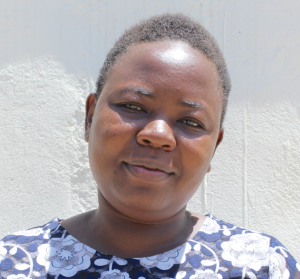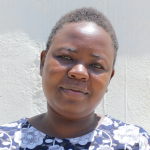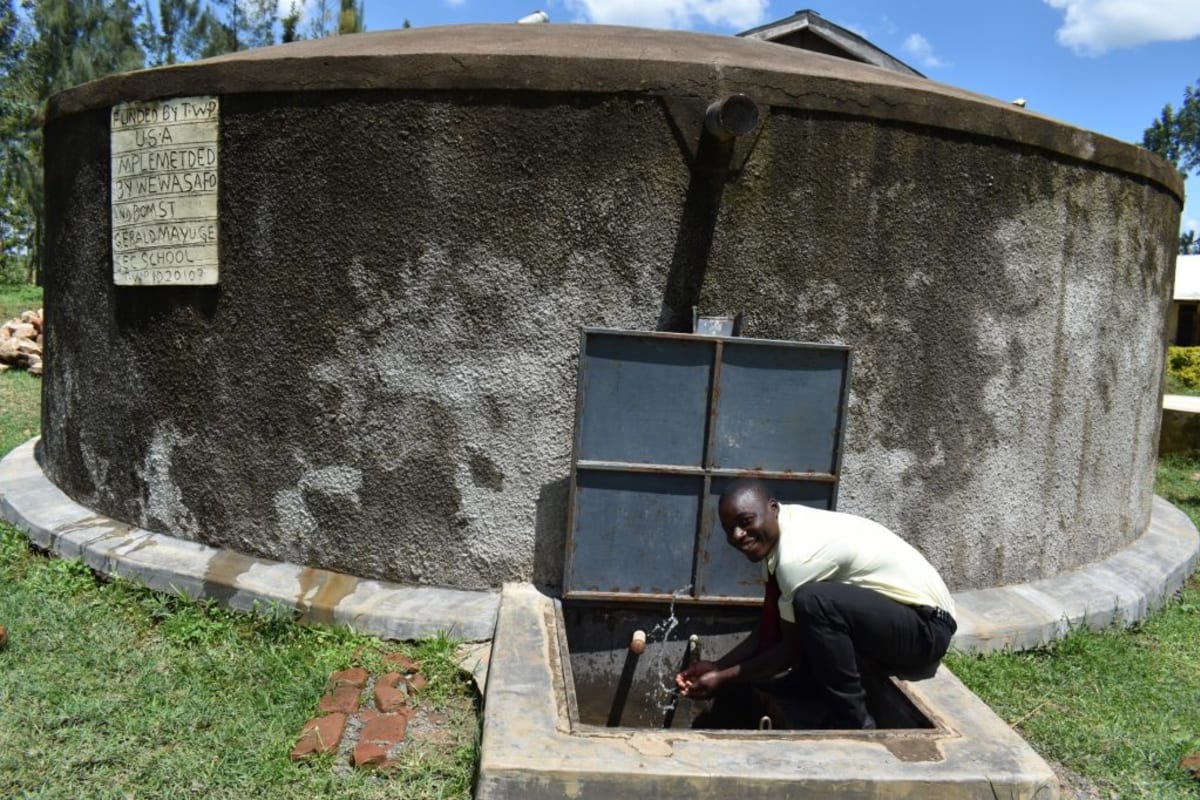May, 2020: St. Gerald Mayuge Secondary School Project Complete!
Please note, all photos in this report were taken before social distancing recommendations went into effect.
St. Gerald Mayuge Secondary School in Kenya now has access to a new source of safe, clean water thanks to the completion of their rain tank, which has the ability to collect 75,000 liters of water! We installed new latrines and handwashing stations for students, and we trained students and staff on improved sanitation and hygiene practices. All of these components work together to unlock the opportunity for these students to live better, healthier lives.

Girls pose with the new rain tank
"I will improve in my performance since I will be at school all the time and will no longer waste time searching for water. Those in Form 4 will benefit from this water point since they will use the water for irrigating their tree planting projects due for examination," said John, who was all smiles at the rain tank.

Pupil John smiles while holding a cup of clean water from the tank
Teachers were just as excited as the students about the new rain tank on campus.
"We shall be able to clear our syllabi within the time frame and start revision, which will lead to good performance. The rate of absenteeism will reduce because the water in the tank is well-stored and treated to ensure that it's clean and safe for human consumption, thus reducing waterborne diseases," said teacher Fredrick Omondi.

Teacher Fredrick Omondi
"To add on that, performance will also improve since students will no longer waste time looking for water, but use that time to study."

Boys collect water from the rain tank
While Kenyan schools remain closed until further notice due to the COVID-19 pandemic, these new water and sanitation facilities will be ready and waiting for the students' return.

A student at the rain tank
Rain Tank
Construction for this 75,000-liter rain tank was successful!
Before schools closed, parents, staff, and students helped our artisans gather everything needed for construction. All the while, the school cooks and community members prepared meals for the artisans, and the school provided accommodations for the artisans during their work. Local women and men helped our artisans with their manual labor, too.

Local man hired to deliver water needed for construction using a cart
The process officially began with our staff and school administration looking around the school compound to try and determine the best location for a new rain tank. This needed to be the best site with enough land and a nearby building with good, clean roofing to catch the rainwater.

Excavation of the rain tank site
Then, we cleared the site by excavating the soil to make level ground for the tank foundation. The foundation was cast by laying big stones on the level ground and reinforcing them using steel wire, concrete, and waterproof cement. We affixed both the drawing pipe and the drainage pipe as we laid the foundation.

Affixing the wire skeleton to the concrete foundation
Next, we formed the outer walls using a skeleton of rebar and wire mesh with sugar sacks temporarily tied to the outside as backing. This skeleton was attached to the foundation’s edges so that the work team could start the Ferro-cementing process, in which the walls are layered with cement alternating with the inner and outer side until 6 layers of cement are in place. (We remove the sugar sacks once the interior receives its first 2 layers of cement.)

Artisan and team start with interior cement work
Inside the tank, we cast 1 central and 4 support pillars to ensure the dome does not cave in once cemented. Meanwhile, we plastered the inner wall while roughcasting the outer walls. Outside of the tank, the access area to the tap was dug, plastered, and a short staircase installed, along with a soak pit where spilled water can drain from the access area through the ground. This helps to keep the tap area dry and tidy.

Working on plaster for interior support pillars
Dome construction could begin after the tank walls had been given enough time to settle. Using similar techniques as used on the walls, the dome started as rebar, wire mesh, and sugar sacks and was attached to the tank walls before receiving cement and plaster. A small manhole cover was built into the dome to allow access for future cleanings and water treatments.

Constructing the access area for the tap and drainage pipe
Long wooden poles (about 75 of them!) were placed inside the tank to support the dome while it cured. A lockable manhole cover was fitted over the tap area, the gutters were affixed to the roof and the tank, and an overflow pipe was set in place at the edge of the dome for when the tank reaches capacity.

Dome construction underway
Once finished, the rain tank was given 3-4 weeks to undergo complete curing. Finally, the interior support poles and dome sugar sacks were removed, the tank was cleaned, and we waited as rain filled the tank with fresh water. When there was a sufficient volume in the tank, we treated the water and we officially handed it over to St. Gerald Mayuge Secondary School.

A student at the rain tank
As soon as it was ready, students and staff celebrated the presence of clean water on campus. The event was a great chance for us to acknowledge the school administration and students as the primary parties entrusted with the tools we have given, as well as remind them of our continued support as they develop. Happiness, thanksgiving, and appreciation were the order of the day flowing in all directions.

A student at the rain tank
VIP Latrines
This project funded the installation of 6 new ventilated improved pit (VIP) latrines, half for girls, and a half for boys. All of these new latrines have cement floors that are designed to be easy to use and clean, locking doors for safety and privacy, and vents designed to keep air flowing up and out through the roof. With a rain tank right on school property, there should be enough water to keep them clean.

Girls celebrate their new VIP latrines
Handwashing Stations
The 2 handwashing stations were set up during training and handed over to the student health club. These were placed outside of the girls’ and boys’ latrines to encourage handwashing after latrine use. Health club members will teach other students how to properly wash their hands at the stations, make sure the stations are filled with water, and work to ensure that there is always a cleaning agent such as soap or ash available.

A boy using a new handwashing station
New Knowledge
Hygiene and sanitation training was scheduled with the help of the school principal, who ensured that the training date would be convenient for students, staff, and parent representatives. Individual teachers helped by selecting students from each class to represent the others. When the training day arrived, facilitators Betty Muhongo and Rose Serete deployed to the site.

We had lots of participation at training
24 students attended training, which was held under a tree. Since the hot weather was not conducive for a classroom discussion, holding it under a tree was so enjoyable because of the fresh breeze. The Deputy Principal requested we have our training in the afternoon because students were finishing up the exams in preparation for their half term.

Trainer Betty leading a session
While the student turnout was as expected, we could not say the same for the invited adults. We had requested the school administration to incorporate at least 1 board member and 1 parent representative into the training. As it turned out, however, the principal was bereaved and so the other adults had joined him for funeral arrangements. Though we only had teachers and students, we continued with the training as planned to make the most use of the students' time.

Students in a group discussion
We covered a number of topics including personal hygiene such as bathing, oral hygiene, and the 10 steps of handwashing; environmental hygiene; child rights; operation and maintenance of the rain tank, latrines, and handwashing stations; and leadership and governance. During the latter, the students elected their peers to lead their newly formed student health club.

A pupil stands to report back the work from her breakout group
Because we held this training when the spread of COVID-19 was still in its early stages and was not yet worldwide, this was not a topic we covered. Since then, however, we have developed trainings exclusively on COVID-19 prevention and awareness - see for yourself what we've been up to more recently as we continue to fight COVID-19 on the frontlines in all of the communities we serve.

A student volunteers to demonstrate good toothbrushing technique
Leading up to the election of the student health club leaders, our discussion on leadership was particularly memorable. The facilitator started by asking the participants if anyone was already in a leadership position at school, and indeed, several of the students confirmed they were. One teacher mentioned that leadership in their school is based on performance, discipline, and cleanliness, among other values.

Holding a package of menstrual pads, Trainer Betty leads the menstrual hygiene management session
We continued brainstorming other qualities a good leader might possess, such as honesty, punctuality with work, and respect for others of all ages. When it came time for the election, it was so exciting because the girls wanted to lead the club alone. For gender balance purposes, we agreed to have a balance of girls and boys at the helm of the club. Those elected were chosen for their qualities that others had named earlier in the brainstorming session. The students said this was their school's very first club. This made the process feel well-understood and special.

Students work through their brainstormed ideas of obstacles students face when trying to complete their secondary education
The club will be greatly involved in the water, sanitation, and hygiene project management at school and will be responsible for encouraging good health and hygiene practices amongst their peers, teachers, and the larger community. We involved stretches, dances, and physical activities in between each topic to keep the pupils’ energy up and their minds active. By the end of the training, each pupil understood their role in sustaining clean water and good health within their school community.

Girls giving their full attention to the speaker at the training
Personal hygiene was another memorable topic as we were able to learn more about the challenges the girl child faces at the age of the students. We discussed some of the reasons why girls drop out of school. These included high levels of poverty leading to early marriage, and the lack of sanitary towels that drives many girls into risky sexual behavior in exchange for money to purchase pads.

Handwashing practical
"The training was very educational. Under personal hygiene, I was able to learn how to change the pad after every 4 hours, not 8 as it is written on the cover," said pupil Esther.

Students must demonstrate proper cleaning of their latrines during training; here, the student uses ash as a locally available alternative to soap
When an issue arises concerning the water project, the students and teachers are equipped with the necessary skills to rectify the problem and ensure the water point works appropriately. However, if the issue is beyond their capabilities, they can contact our team of field officers to assist them. In addition, we will continue to offer them unmatchable support as a part of our ongoing monitoring and maintenance program.
Thank you for making all of this possible!




 Rehabilitation Project
Rehabilitation Project



















































